Having lauded the glories of gardens and the virtues of vegetables, it’s time to acknowledge those who make it all possible…no, not gardeners….think smaller………..infinitely smaller………yep, insects. Those most beautiful pollinators – butterflies are frequently featured on handkerchiefs.
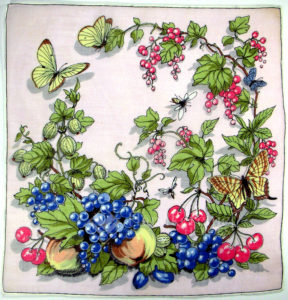
“Butterflies are not insects… they are self propelled flowers.”
Robert A. Heinlein, The Cat Who Walks Through Walls
Their inspiring metamorphosis from crawling creature to winged wonder has led several cultures to imbue them with the symbolism of rebirth and new beginnings, which is why butterfly images are often found on wedding handkerchiefs and christening bonnets.
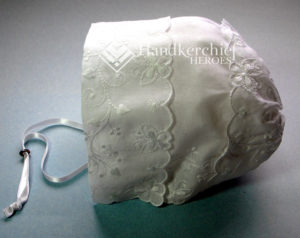 |
 |
“I almost wish we were butterflies and liv’d but three summer days – three such days with you
I could fill with more delight than fifty common years could ever contain.”
John Keats, Bright Star: Love Letters and Poems of John Keats to Fanny Brawne
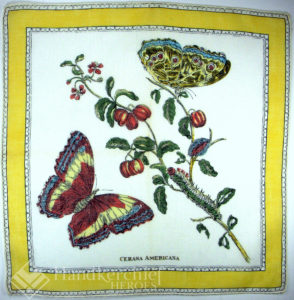
Children find insects fascinating, so it’s no surprise their images frequently adorn tiny hankies. One little caterpillar even sports an umbrella!
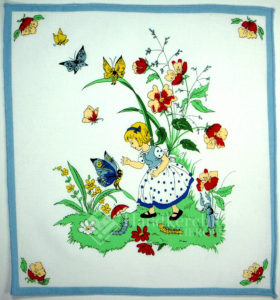
A bright blue beetle, hoe in hand, supervises raspberry picking.
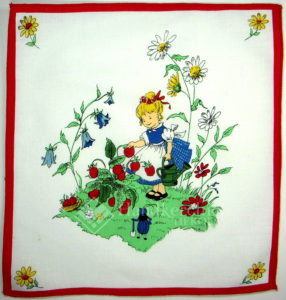
Raspberries are joined by cherries, peaches, pears and citrus slices, surrounded by…bees!
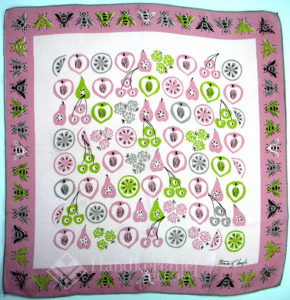
There’s no escaping these mini-marvels, and in the hankie on the right they’re joined by ants.
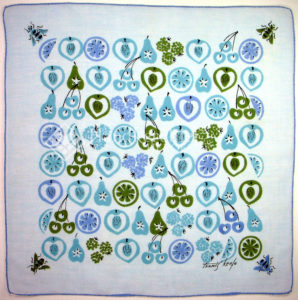 |
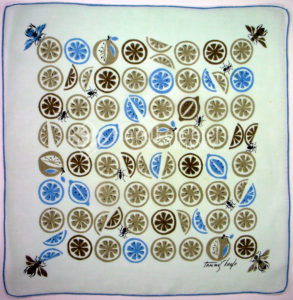 |
Bees swarm around this bashful bunny. We know from his googly eyes and raised brows he’s about to get a serious warning and best beat a hasty retreat.
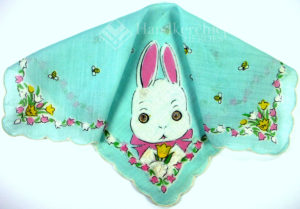
An often cited statistic which has garnered much attention:
“If the bee disappeared off the face of the earth, man would only have four years left to live.”
Maurice Maeterlinck, The Life of the Bee
Although this statement has been refuted by entomologists, nevertheless, when our survival is challenged, man sits up and takes notice, viewing what he formerly considered a bothersome creature with newfound respect. We now know we depend on pollinating insects for 70% of the crops we eat.
Drones, worker bees and the queen, in a sea of heavenly pink blossomed clover.
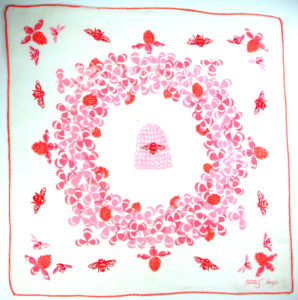
An equally handsome tableau in green, complete with hexagonal honeycomb. Stunning.
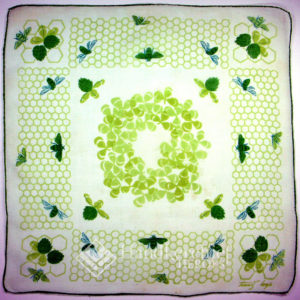
A walk in the woods would surely include encounters with the following…
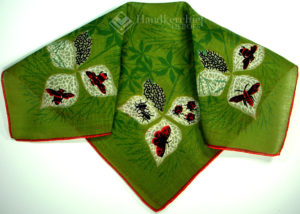
The same image in aubergine evokes a crisp fall afternoon.
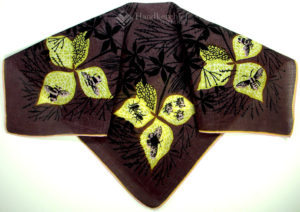
The artist (Tammis Keefe) is so skilled with color choices, I like to offer you variations when I can. We’ve spoken of Keefe before, an urbane and discriminating artist we lost too soon in 1960. She was prescient and sophisticated in her choice of subject matter, color selection, illustrative style, layout, and so much more.
Here’s a hive I wouldn’t want to tackle. You can almost hear the hundreds of wings vibrating. The calm gray spiked with sentinels flashing “Keep Out” warnings in hot pink and cinnamon, convey the message in a single flash.
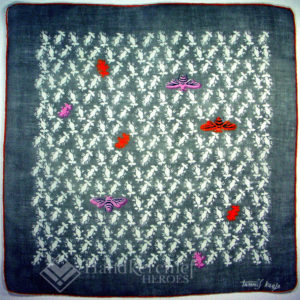
Note how the bees form a multi-directional pattern of never ending sharp angles. In stark contrast, the image below, using a similar layout, creates a friendly, undulating backdrop for lazy dragonflies who appear to skim low over a sparkling pond, rippling in the warm summer breeze. Similarly structured, yet radically different in tone. Keefe always manages to get it right.
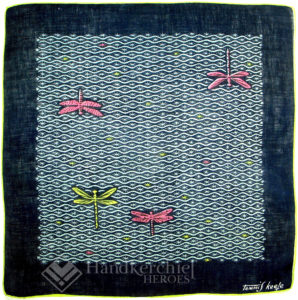
Beautiful as butterflies, yet more exotic in structure, dragonflies are a popular handkerchief image. Legend has it that dragonflies were given an extra set of wings so a tiny angel could ride on its back; whenever you see a dragonfly, it’s a sign of “love from above.” The dragonflies on this pale pink hankie are rendered in gold metallic paint, so we know this piece was strictly for fashion, not function.
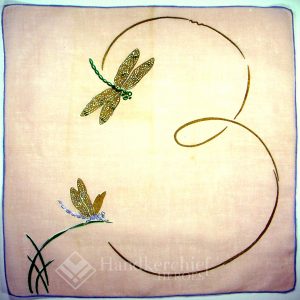
Glorious dragonflies and butterflies flit among the ferns.
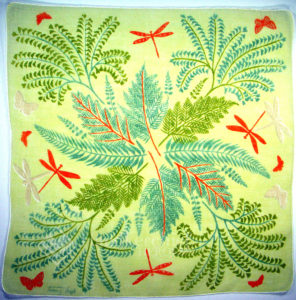
Dragonflies can fly/lift straight up or down, hover like a helicopter, and even mate mid-air. If they can’t fly they’ll starve because they only eat prey they catch while flying. They inspired engineers to try to design robots to fly like they do. Perhaps that’s the origin of drones?

Having flown the earth for 300 million years, dragonflies symbolize our ability to overcome times of hardship. According to Smithsonian.com, fossil dragonflies have been found with wingspans of up to two feet!
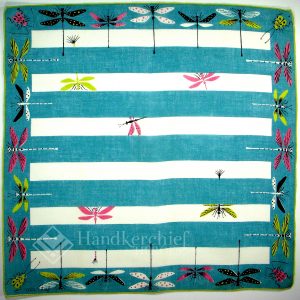
Take a gander at what’s really happening under your picnic blanket. Note the tiny campfire dead center, the stripped bathing suit hanging up to dry, the snail with the sniffles, the ant on his back reading a book, the worm with knapsack and sunhat, multiple picnic baskets and more. Fun!
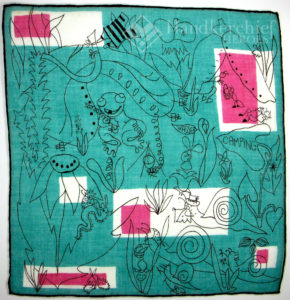
Where would we be without a ladybug to land on our shoulder for good luck? Farmers love these colorful creatures as a single ladybug can eat up to 5,000 aphids in its lifetime. You can find several ladybug hankies in our blog on luck.
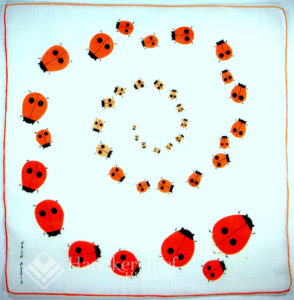
Busy as a Bee…no kidding!
A hive of bees must fly anywhere from 55,000 to 90,000 miles and visit two million+ flowers to produce one pound of honey. The average worker bee produces about 1/12th of a teaspoon of honey in her lifetime. (six weeks) The bee visits 50 to 100 flowers during a collection trip, which can last for six miles, with flying speeds reaching fifteen miles an hour. Whew!

“We don’t give a damn to the insects on our Earth, but if we could find
even a single insect on Mars, the whole world would cherish it like crazy!”
Mehmet Murat Ildan
Fun Facts
Honeybees communication with each other by dancing.
Honey is the only food that includes all the substances necessary to sustain life – enzymes, vitamins, minerals and water. It also contains pinocembrin, an antioxidant association with improved brain functioning.
A dragonfly called the globe skinner has the longest migration of any insect – 11,000 miles back and forth across the Indian Ocean. On the opposite extreme, green darners from New Jersey only travel every third day and average around 7.5 milers per day. Come on Jersey, kick it up a notch. ☺
What species are the fastest land insects? Australian tiger beetles, which have been clocked at 4.2 miles per hour.
What is the only insect known to have just one ear? The preying mantis. Its ear has two eardrums, and is capable of picking up ultrasonic sounds, which is essential in detecting the echolocation cries of the bat, one of its biggest predators.
=========================================================================
We hope you enjoy our new You Tube channel and visit periodically to see what’s new and share with your friends…





These are all so good. The pink one with the housefly border is super pretty. You come up with the most creative topics.
You’re kind to say so and I appreciate your interest.